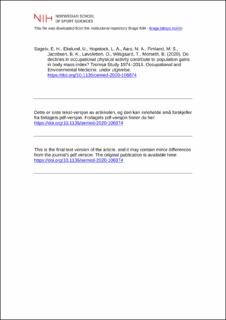Do declines in occupational physical activity contribute to population gains in body mass index? Tromsø Study 1974–2016
Sagelv, Edvard Hamnvik; Ekelund, Ulf; Hopstock, Laila Arnesdatter; Aars, Nils Abel; Fimland, Marius Steiro; Jacobsen, Bjarne K.; Løvsletten, Ola; Wilsgaard, Tom; Morseth, Bente
Peer reviewed, Journal article
Accepted version
Permanent lenke
https://hdl.handle.net/11250/2727064Utgivelsesdato
2020Metadata
Vis full innførselSamlinger
- Artikler / Articles [2119]
- Publikasjoner fra Cristin [1107]
Originalversjon
Occupational and Environmental Medicine. 2020, under utgivelse. 10.1136/oemed-2020-106874Sammendrag
Objective: To examine whether occupational physical activity changes predict future body mass index (BMI) changes. Methods: This longitudinal cohort study included adult participants attending ≥3 consecutive Tromsø Study surveys (examinations 1, 2 and 3) from 1974 to 2016 (N=11 308). If a participant attended >3 surveys, the three most recent surveys were included. Occupational physical activity change (assessed by the Saltin-Grimby Physical Activity Level Scale) was computed from the first to the second examination, categorised into persistently inactive (n=3692), persistently active (n=5560), active to inactive (n=741) and inactive to active (n=1315). BMI change was calculated from the second to the third examination (height being fixed at the second examination) and regressed on preceding occupational physical activity changes using analysis of covariance adjusted for sex, birth year, smoking, education and BMI at examination 2. Results: Overall, BMI increased by 0.84 kg/m2 (95% CI 0.82 to 0.89). Following adjustments as described previously, we observed no differences in BMI increase between the occupational physical activity change groups (Persistently Inactive: 0.81 kg/m2, 95% CI 0.75 to 0.87; Persistently Active: 0.87 kg/m2, 95% CI 0.82 to 0.92; Active to Inactive: 0.81 kg/m2, 95% CI 0.67 to 0.94; Inactive to Active: 0.91 kg/m2, 95% CI 0.81 to 1.01; p=0.25). Conclusion: We observed no prospective association between occupational physical activity changes and subsequent BMI changes. Our findings do not support the hypothesis that occupational physical activity declines contributed to population BMI gains over the past decades. Public health initiatives aimed at weight gain prevention may have greater success if focusing on other aspects than occupational physical activity.
Beskrivelse
I Brage finner du siste tekst-versjon av artikkelen, og den kan inneholde ubetydelige forskjeller fra forlagets pdf-versjon. Forlagets pdf-versjon finner du på bjsm.bmj.com / In Brage you'll find the final text version of the article, and it may contain insignificant differences from the journal's pdf version. The definitive version is available at bjsm.bmj.com
